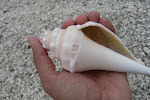 Chrissie, Devon and Lindsey at the top of the hike.
Chrissie, Devon and Lindsey at the top of the hike.
Their schedule worked for me since I usually immerse myself in nature on Saturday’s after church anyway and it matched their request to venture out when the sun wasn’t so intense. It turned out to be an overcast day too which spared us a couple of digits temperature wise.

A view of the fringing reef.

The islet known by the name Forbidden.

Not only is Forbidden Island a scary name, but this sign gives a clear warning why care needs to be taken at this site. I always advise visitors to go with a guide that is familiar with the place. This area is full of Scaevola sericea, shrubs commonly known as Half-flowers.

The hidden pool.
 The tide was very low even inside the hidden pool. We were actually able to stand on the bottom of the pool because it was so low! Luckily, the swimming area at the end of the beach was calm and deep enough for us to enjoy. We jumped in, cooled off, saw a few crabs and Abudefdufs (Sargeant major damselfish), and traded stories on stonefish.
The tide was very low even inside the hidden pool. We were actually able to stand on the bottom of the pool because it was so low! Luckily, the swimming area at the end of the beach was calm and deep enough for us to enjoy. We jumped in, cooled off, saw a few crabs and Abudefdufs (Sargeant major damselfish), and traded stories on stonefish.
Chrissie is Hawaiian and spent some in the Marshall Islands last year teaching. We shared some Hawaiian plant lore and I will share with you now one of my favorites, the famous story of:
The Naupaka
In the time of the ancients, there was a beautiful Hawaiian princess named, Naupaka. The villagers started noticing that their princess was often very sad. They approached her parents, who then asked Naupaka why she was troubled."
I have fallen in love with Kaui," the princess said. "But Kaui is not of noble birth. He is a fisherman; a commoner." In Hawaiian tradition, it was strictly forbidden for those of royal lineage to marry a commoner. Hearing this broke her parents’ hearts.
Together, Naupaka and Kaui climbed up a high mountain to see a wise kahuna (chief) to seek his advice. The wise kahuna lived in a heiau (temple) on top of the mountain but his wisdom failed him this time as there was no clear answer for the young lovers. His only advice for them was for them to offer prayers at the heiau.
As the young lovers prayed, rain began to fall reflecting the sorrow that was in their hearts. They knew the answer then. It seemed that their gods will never allow them to be together. Broken hearted, Naupaka and Kaui embraced for the last time to say good bye. Naupaka took a flower from her ear and tore it in half and gave the other half to Kaui. Naupaka said, “I will leave you here in the mountains, while I go back to our people by the sea."

The Hawaiian people named these flowers Naupaka after their princess who was banished to the sea forever separated from her lover who was banished to the mountains. It is said that to bring together a Mountain Naupaka and a Beach Naupaka is to reunite the two lovers.
Aside from this version of the legend, the Beach Naupaka (Scaevola sericea) also known as Naupaka Kahakai (literally Naupaka by the sea), is one of the most common beach plants in tropical and subtropical Pacific and Indian Ocean coasts. In Chamorro, it is called Nanaso. The shrubs typically have large leaves. Their small half flowers are white with purplish streaks and bloom in clusters. The fruits are white and the juice can be squeezed into the eyes to relieve soreness. The young leaves are cooked and eaten in India as a vegetable.

Mountain Naupaka
In Hawaii, there are nine different species of Naupaka, and six of them are endemic and only found there. The Naupaka Kaahiwi or Mountain Naupaka is one of them. I've been told that it differs from the Beach Naupaka in that it has a mild sweet fragrance which the beach Naupaka lacks. Its leaves are also pointed and serrated.
To me, the legend of the Naupaka is a reminder that sometimes, to be with the one that you love is just as difficult as uniting the mountain with the sea. Or at times, love may never bloom completely.
Ti napu,
The Beachcomber
(I didn't have my camera with me that day so thank you Chrissie for you and the girls' photos! Also I need to give photo credits for the Mountain Naupaka to Forest & Kim Starr (USGS) and Wikipedia, the free encyclopedia for the Beach Naupaka).




 It will never do you justice.
It will never do you justice. Galatea, my muse, should I envy Pygmalion?
Galatea, my muse, should I envy Pygmalion? A special yummy breakfast with the girls! (May 10, 2008)
A special yummy breakfast with the girls! (May 10, 2008)

 "Veggie dog, anyone?" (Sundown at Ladder Beach, May 9, 2008)
"Veggie dog, anyone?" (Sundown at Ladder Beach, May 9, 2008)



